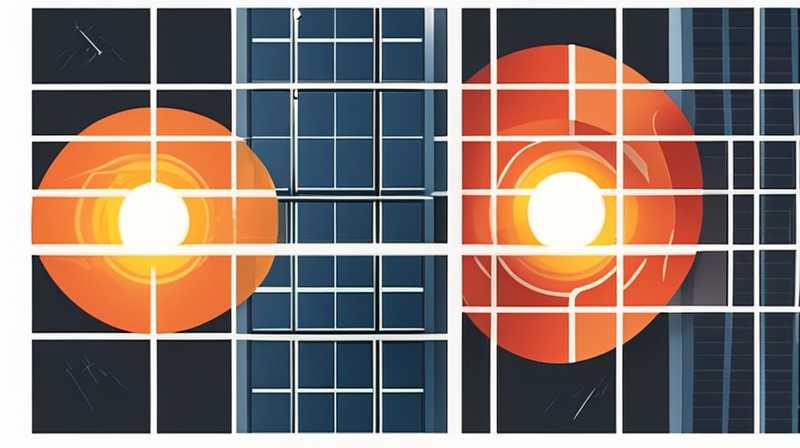
To effectively repair cracked solar panels, several procedures can be followed to ensure the panels continue to function optimally. 1. Assess the damage carefully, 2. Clean the surface meticulously, 3. Use appropriate adhesive materials, 4. Seal the cracks properly. The first step involves evaluating the extent of the damage; small cracks may be repaired with specific adhesives, while larger issues might require professional assistance or panel replacement. A thorough examination is crucial because even minor imperfections can significantly reduce efficiency. Performing these actions may enable a solar panel system to regain functionality, although preventative measures and proper installation are paramount in sustaining the longevity of such equipment.
1. ASSESSING THE DAMAGE
To begin addressing issues with solar panels, comprehensively assessing the damage is indispensable. Not all cracks exhibit equal severity; thus, identifying the type and extent of the damage is paramount. Surface fractures may result from environmental factors like hail or falling debris, while deeper fissures may indicate underlying structural problems that imperil the entire system. A visual inspection followed by functional testing using a multimeter can provide insight into the electrical performance of the panels.
During this initial phase, consider documenting the damage through photographs, which can help track the progression of the issue over time. It is vital to differentiate between superficial cracks that may only affect aesthetics from those that could lead to significant energy losses or hazardous electric shocks. Furthermore, assessing surrounding components like wiring, junction boxes, and inverters is also critical, as these elements may sustain damage during the same incident.
2. CLEANING THE SURFACE
Following the assessment, the next essential action is cleaning the surface of the cracked solar panels. Debris, dirt, and other contaminants can hinder the effectiveness of the subsequent repair process. Thorough cleaning not only improves visibility for further inspection but also ensures that adhesive materials can bond effectively.
Using distilled water, a mild soap, and a soft cloth or sponge is highly recommended for this task. Avoid abrasive pads or harsh chemical cleaners, as these can exacerbate existing damage or scratch the glass surface. After initial cleaning, inspect the area again to see if there are any additional cracks or issues that were previously obscured by dirt or grime. Paying attention to details during this phase can lead to a more successful long-term solution.
3. USING ADHESIVE MATERIALS
Once the panels have been cleaned, the next step involves using appropriate adhesive materials to mitigate the impact of cracks. Different types of adhesives are available, with options like silicone sealants or epoxy being among the most widely used. It’s crucial to select a product specifically designed for outdoor use and compatible with solar panel materials.
Applying adhesive requires precision; start by carefully injecting or applying the adhesive directly into the fissures. Follow the manufacturer’s instructions for curing times and conditions to ensure an optimal bond. In some cases, placing clear tape over the crack may help hold the adhesive in position while it dries. When working with these materials, safeguarding personal safety is crucial. Always wear protective gear, including gloves and goggles, to avoid exposure to chemicals that could pose health risks.
4. SEALING THE CRACKS
After applying the adhesive, the last significant step is fully sealing the cracks. Sealing not only protects the repaired area from further environmental stress but also enhances the overall integrity of the solar panel system. A proper seal can reduce moisture intrusion, which is vital for both performance and longevity.
Consider using a sealant compatible with the adhesive you’ve chosen. Carefully apply a thin layer over the repair area to ensure complete coverage. It’s also advisable to check the product specifications to confirm its compatibility with solar glass. Allow ample time for curing, and once it has set, perform another thorough inspection of the entire panel to guarantee the repairs hold and no further issues have emerged. A well-sealed panel not only enhances durability but can also improve efficiency by preventing future damage.
FREQUENTLY ASKED QUESTIONS
WHAT TO DO IF THE CRACK IS TOO LARGE?
If a crack is beyond the feasible repair scope, it may necessitate complete replacement. Assessing the age of the panel is important, as older panels tend to be less efficient and may not justify repair costs. Consult an expert to evaluate whether the existing system’s overall efficacy and the cost of repair outweigh the benefits, and determine the most suitable course of action.
CAN SOLAR PANELS STILL OPERATE WITH CRACKS?
Yes, solar panels can continue to function even with cracks. However, efficiency may diminish significantly, especially if the structural integrity is compromised. Regular monitoring and performance evaluations will help identify any decline in energy production. It is advisable to promptly address any evident damage to prevent escalated concerns affecting efficiency.
HOW OFTEN SHOULD SOLAR PANELS BE INSPECTED?
Regular inspection of solar panels is essential to ensure optimal performance. Conduct visual checks at least twice a year, and consider functionality tests whenever harsh weather occurs. Storms, hail, or other extreme conditions can result in hidden damage. Frequent assessments allow for timely interventions, maximizing energy production and extending the lifespan of the panels.
Maintaining the integrity of solar panels is crucial for ensuring sustained performance and minimizing costly replacements. Understanding how to address issues related to cracks encompasses various stages, from assessing the damage to executing proper sealing techniques effectively. By systematically following the recommended measures, one can preserve the functionality of solar panels, ensuring they continue to generate renewable energy efficiently. This proactive approach not only optimizes individual panel productivity but also contributes to supporting overall environmental sustainability goals. Engaging professional services may sometimes be prudent for severe damage, but with diligence and care, many issues can be resolved through informed action.
Original article by NenPower, If reposted, please credit the source: https://nenpower.com/blog/how-to-repair-cracked-solar-panels/


